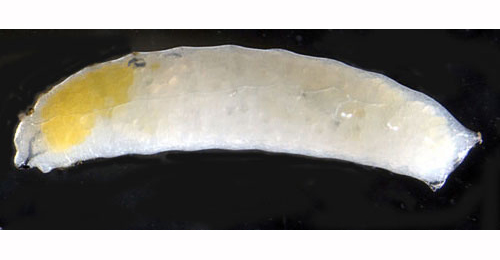|
||||||
|
Liriomyza
sonchi Hendel, 1931 Liriomyza
sonchi Hendel, 1931. Fliegen palaearkt.
Reg. 6(2): 247 |
|||||||||||||||||||||||||||||||||||||||||||||||||||||||||||||||||||||||||||||||||||||||||||||||||||||||||||||||||||||||||||||||||||||||||||||||||||||||||||||||||||||||||||||||||||||||
|
Leaf-miner: A small primary blotch, often several larvae feeding together (Spencer, 1972b: 56 (fig. 186); Spencer, 1976: 270, 271 (fig. 483)). Brown, upper-surfsce blotch; often several larvae in a mine. The blotch is preceded by a short initial corridor, often overrun by the later blotch. Frass in a few, small grains. Secondary feeding lines well visible. Pupation outside the mine, exit slit in upper epidermis (Bladmineerders van Europa). Small upper surface blotch, with occasional galleries leading from the blotch. Often several larvae feeding together (British leafminers). Larva: The larvae of flies are leg-less maggots without a head capsule (see examples). They never have thoracic or abdominal legs. They do not have chewing mouthparts, although they do have a characteristic cephalo-pharyngeal skeleton (see examples), usually visible internally through the body wall. The larva is briefly described by de Meijere (1925, as hieracii), Hering (1957a), Sasakawa (1961) and illustrated in Bladmineerders van Europa. Posterior spiracles each with an ellipse of 8-10 bulbs (Spencer, 1976: 270).
Puparium: The puparia of flies are formed within the hardened last larval skin or puparium and as a result sheaths enclosing head appendages, wings and legs are not visible externally (see examples). The puparium is illustrated in Bladmineerders van Europa.
Comments: The host-specificity of sonchi has been experimentally tested in Canada (Peschken and Derbyshire, 1988: 593-600). The species is restricted to Sonchus, the records of sonchi on Lapsana (Robbins, 1991: 123) and Lactua and Mycelis muralis (Bladmineerders van Europa) require confirmation. Hosts in Great Britain and Ireland:
Hosts elsewhere:
Time of year - mines: June-September. Time of year - adults: Currently unknown. Distribution in Great Britain and Ireland: Widespread, at least in south. Records include London (Hampstead), Middlesex (Scratch Wood), Berkshire (Pangbourne) (Spencer, 1972b: 57); Warwickshire (Robbins, 1991: 123); Cambridgeshire, East Suffolk, Glamorgan, Isle of Wight, South Lancashire and Surrey (NBN Atlas). Also recorded in the Republic of Ireland: Co. Clare, Co. Wexford (Rosslare) (Spencer, 1972b: 57). Distribution elsewhere: Widespread and common in much of Europe including Denmark, Sweden, Norway, Finland (Spencer, 1976: 270), The Netherlands (Bladmineerders van Europa), Belgium (de Bruyn and von Tschirnhaus, 1991), Germany (Spencer, 1976: 558), Austria, Czech Republic, French mainland, Hungary, Italian mainland, Lithuania, Poland, Slovakia and Spanish mainland (Fauna Europaea). Also recorded in Canada (Peschken and Derbyshire, 1988). NBN Atlas links to known host species:
British and Irish Parasitoids in Britain and elsewhere:
|
| Last updated 09-Jul-2019 Brian Pitkin | ||


